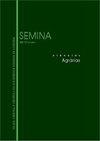Prevalence and risk factors for Leptospira spp. in dairy cattle in western Paraná, Brazil
IF 0.5
4区 农林科学
Q4 AGRICULTURE, MULTIDISCIPLINARY
引用次数: 0
Abstract
Leptospirosis is caused by spirochete bacteria of the genus Leptospira and is considered the most widespread zoonosis worldwide. It is an important agent that causes animal production to decrease. In cattle, it affects especially the reproductive tract. The objective of this study was to determine the seroprevalence of Leptospira spp., molecularly detect the bacteria in tissues of aborted fetuses, and identify the main risk factors associated with infection in cattle in dairy farms in Western Paraná. For this purpose, 600 bovine serum samples from 60 properties and 17 bovine fetuses from nine properties were collected. Data about the properties were also collected through an epidemiological questionnaire to assess the main risk factors associated with Leptospira spp. infection. The serum samples were analyzed using microscopic agglutination test (MAT), and the fetal tissues using nested polymerase chain reaction (nested PCR). Seroprevalence of Leptospira spp. in dairy cattle in Western Paraná was 39.83% (239/600) and none of the analyzed fetuses were positive for Leptospira spp. The main risk factors identified are related to the production system, reproductive management, and the presence of dogs on the property. Leptospira spp. infection is widely spread in the cattle population in Western Paraná.巴西帕拉那亚西部地区奶牛钩端螺旋体的流行及危险因素
钩端螺旋体病是由钩端螺旋体属的螺旋体细菌引起的,被认为是世界上最广泛的人畜共患病。它是导致动物产量下降的重要因素。在牛身上,它尤其影响生殖道。本研究的目的是确定钩端螺旋体的血清阳性率,分子检测流产胎儿组织中的细菌,并确定与西部paranar 奶牛场牛感染相关的主要危险因素。为此,收集了60种牛种的600份牛血清和9种牛种的17个牛胎。通过流行病学调查问卷收集了有关钩端螺旋体感染的主要危险因素的数据。采用显微凝集试验(MAT)分析血清样本,采用巢式聚合酶链反应(巢式PCR)分析胎儿组织样本。西部paranar地区奶牛中钩端螺旋体的血清阳性率为39.83%(239/600),胎儿中未检测出钩端螺旋体阳性,主要危险因素与生产系统、繁殖管理和饲养犬有关。钩端螺旋体感染在西帕拉南牛群中广泛传播。
本文章由计算机程序翻译,如有差异,请以英文原文为准。
求助全文
约1分钟内获得全文
求助全文
来源期刊

Semina-ciencias Agrarias
农林科学-农业综合
CiteScore
1.10
自引率
0.00%
发文量
148
审稿时长
3-6 weeks
期刊介绍:
The Journal Semina Ciencias Agrarias (Semina: Cien. Agrar.) is a quarterly publication promoting Science and Technology and is associated with the State University of Londrina. It publishes original and review articles, as well as case reports and communications in the field of Agricultural Sciences, Animal Sciences, Food Sciences and Veterinary Medicine.
 求助内容:
求助内容: 应助结果提醒方式:
应助结果提醒方式:


